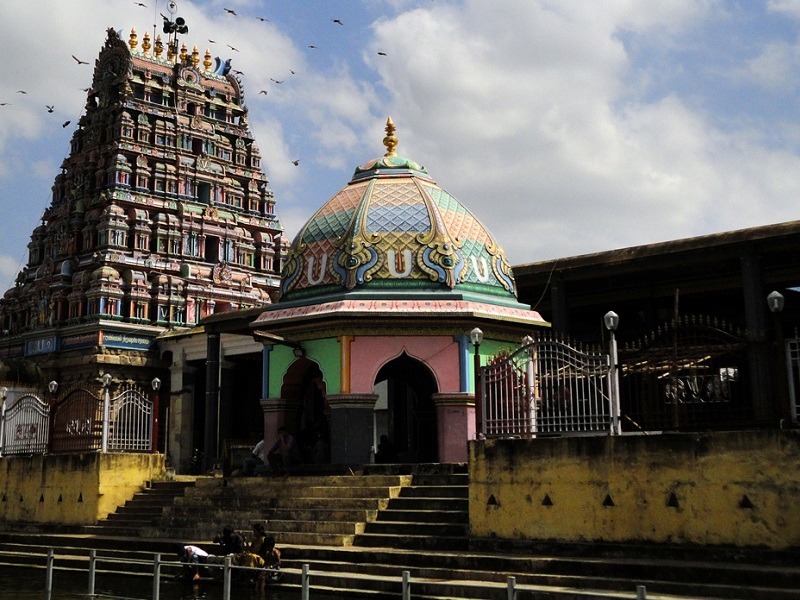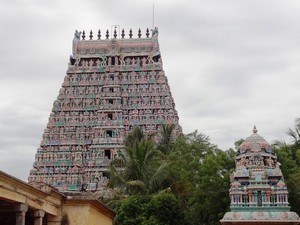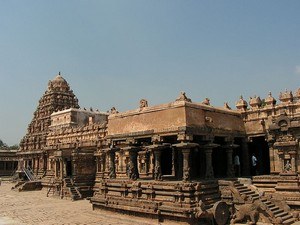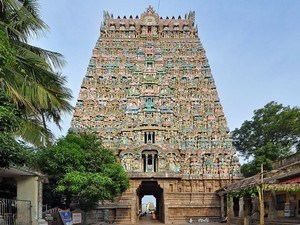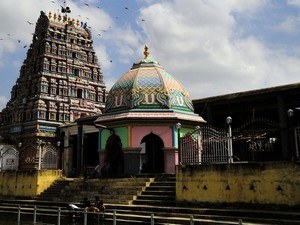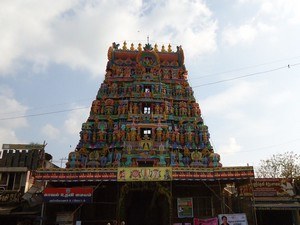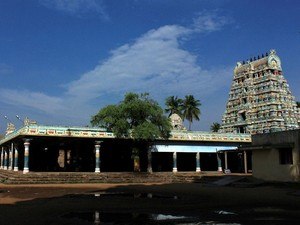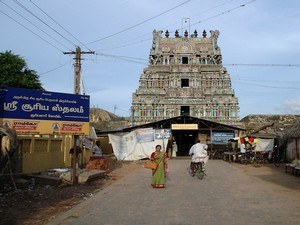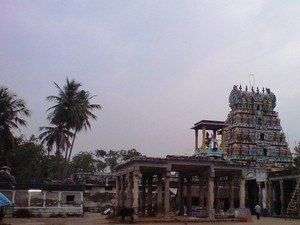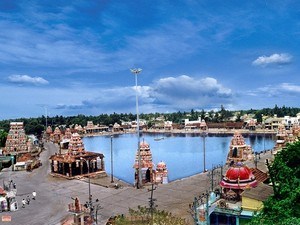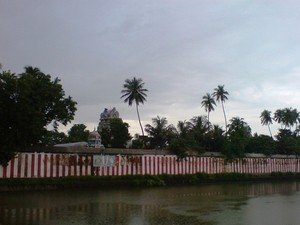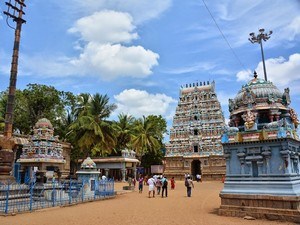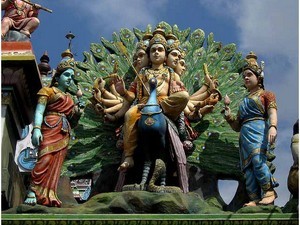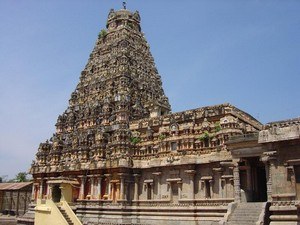Uppiliappan Temple / Oppilliappan Temple, Kumbakonam - Timings, Festivals, History, Darshan, Pooja Timings
Photo Credit: Flickr
 India | TamilNadu | Kumbakonam
India | TamilNadu | Kumbakonam
 #4 of 30 Places to Visit in Kumbakonam
#4 of 30 Places to Visit in Kumbakonam
 Distance (From Kumbakonam Railway Station): 5 Kms
Distance (From Kumbakonam Railway Station): 5 Kms
 Trip Duration (Including Travel): 1 Hour
Trip Duration (Including Travel): 1 Hour
 Place Location: At Thirunageswaram
Place Location: At Thirunageswaram
 Transportation Options: Bus / Cab / Auto
Transportation Options: Bus / Cab / Auto
 Travel Tips: None
Travel Tips: None
About Oppiliappan Temple
At a distance of 5 Km from Kumbakonam Railway Station, Uppiliappan Temple also known as Thiruvinnagar is an ancient Hindu temple situated in Thirunageswaram, a village in the outskirts of the Kumbakonam in Tamil Nadu. The temple is dedicated to Lord Vishnu who is worshippedas Lord Uppiliappan and his consort Lakshmi as Bhumidevi. The temple is glorified in the Naalayira Divya Prabandham, the early medieval Tamil canon of the Alvar saints from the 6th-9th centuries CE. It is counted as the 60th among the 108 Divya Desams dedicated to Lord Vishnu, and also one of the must-include places in Kumbakonam family packages. The temple is one of the Pancha Kshethram, where Goddess Lakshmi was born as Bhargavi, the daughter of the sage Bhrigu.
History of Oppiliappan Temple
The precise history of the temple cannot be established solely through the available inscriptions. Nevertheless, inscriptions from the late 8th century AD, attributed to the Medieval Cholas, reveal significant donations made to the temple. Most of these inscriptions and epitaphs date back to the reigns of Rajendra Chola and Rajaraja Rajakkesarivarman I. The original idol of the main deity was transformed from wood to stone. Additionally, substantial modifications to the temple were carried out by Govinda Dikshitar, who served as the minister under the successive Nayak rulers, Achuthappa Nayak (1560-1614) and Raghunatha Nayak (1600-34). The temple is currently managed and overseen by the Hindu Religious and Endowment Board of the Government of Tamil Nadu.
Mythology of Oppiliappan Temple
Numerous myths and legends are linked to the Oppiliappan Temple in Kumbakonam. The most ancient tale recounts that the sacred plant Tulsi prayed to be close to Lord Vishnu. In response, Vishnu granted the plant a boon, promising that Goddess Lakshmi would manifest in its embrace. Consequently, Tulsi flourished at the site where the temple is currently located.
Years later, Maharishi Markandeya, who worshipped Vishnu, expressed a desire for Lakshmi to be his daughter and Vishnu to be his son-in-law. During a pilgrimage, Markandeya arrived at Thiruvinnagaram and felt it was the ideal location to fulfill his wish. He then undertook a rigorous penance for a thousand years, seeking the blessings of Lakshmi. Ultimately, Lakshmi appeared as an infant beneath the Tulsi plant, and the sage recognized her as the Goddess and raised her.
When the young girl reached adolescence, Vishnu manifested as an elderly man and sought her hand in marriage. Markandeya responded that his daughter was too young to prepare food and did not even know how to use salt in cooking. To this, the Lord replied that he would accept the food even without salt. Confused, the Maharishi prayed to Lord Vishnu for guidance. Subsequently, Lord Vishnu revealed his true form, complete with a conch and discus, and married Goddess Lakshmi at the location of the present temple. According to this legend, the Lord is referred to as Uppiliappan, and no salt is added to the prasadam prepared at the temple.
Architecture of Oppiliappan Temple
Built in the Dravidian architectural style, the temple features a five-tiered rajagopuram with two inscriptions from the Chola era. The temple complex, which encompasses various shrines and a sacred tank, is surrounded by a granite wall. The sanctum is adorned with gold plated roof known as Suddhananda Vimana, meaning 'pure joy.' Within the main shrine resides the image of Oppiliappan in a standing position, accompanied by Bhoomidevi and sage Markendeya. The Utsava deity, Oppiliappan, is never removed from the temple without his consort Bhoomidevi, as he vowed to sage Markandeya that he would not leave his daughter Bhoomidevi unattended while seeking her hand in marriage. Additionally, he is recognized as the brother of Lord Venkateshwara, providing an opportunity for devotees who cannot visit Tirupati to fulfill their vows here.
The temple complex also contains smaller shrines dedicated to Krishna, Rama, Hanuman, Garuda, as well as the Azhwars and saints Ramanuja and Desika. The Hanuman idol is embellished with a diamond crown, a golden sword, and armor. The location where Bhoomidevi is believed to have been born is also part of the temple. The Ahoraathra Pushkarini, the temple tank, is included within the complex. A beautifully adorned temple elephant participates in festival celebrations. Furthermore, the complex features two marriage halls, a guest house with five rooms, two chariots, and a garden for Tulsi plants.
Festivals of Oppiliappan Temple
The chariot festival is the most prominent festival of Oppiliappan Temple, celebrated for 9-days during the Tamil month of Panguni (March/April) and thousands of tourists and pilgrims come to partake in the festivities. Vasanta Utsavam in May/June, Pavitrotsavam in August/September, Brahmotsavam in September/October, Kalyana Utsavam in October/November, Adhyayana Utsavam in December/January and Float festival in January/February are the other prominent festivals celebrated in this temple. Ramanavami is also celebrated for with much zeal and gusto here.
Dress Code & Other Restrictions of Oppiliappan Temple
When planning a visit to the Oppiliappan Temple in Kumbakonam, it is recommended to adhere to modest clothing that covers your upper arms and legs as a sign of respect. Men are encouraged to wear a dhoti or pajama paired with an upper garment, as well as formal trousers and shirts. Women may opt for a saree, half saree, or churidhars. It is advisable to refrain from wearing contemporary attire such as mini-skirts, low-waist jeans, shorts, and sleeveless tops while on the temple grounds.
Non-Hindus are welcome to explore the temple complex and appreciate its architectural beauty; however, access to the sanctum sanctorum may be restricted.
Oppiliappan Temple Timings
Monday: 6 AM - 1 PM & 4 PM - 9 PM
Tuesday: 6 AM - 1 PM & 4 PM - 9 PM
Wednesday: 6 AM - 1 PM & 4 PM - 9 PM
Thursday: 6 AM - 1 PM & 4 PM - 9 PM
Friday: 6 AM - 1 PM & 4 PM - 9 PM
Saturday: 6 AM - 1 PM & 4 PM - 9 PM
Sunday: 6 AM - 1 PM & 4 PM - 9 PM
Oppiliappan Temple Entry Fee
General Entry is Free
Special Darshan available for Rs. 50
Best Time to Visit Oppiliappan Temple
The ideal period to explore Uppiliappan Temple is during the winter season, from October to February, when the climate is enjoyable and temperatures are cooler. It is advisable to avoid visiting during the peak summer months of April to June, as the heat in Tamil Nadu can be quite intense, making temple tours uncomfortable. However, if you are not frightened by warm weather, March and April present an excellent opportunity to visit, as the annual Chariot Festival takes place during this time. The temple is adorned with vibrant decorations and lights, attracting thousands of tourists and pilgrims who come to partake in the festivities.
How to Reach Oppiliappan Temple
Trichy Airport is the nearest airport, situated about 95 kilometers from Kumbakonam. The Kumbakonam Railway Station provides comprehensive train services to numerous cities, including Chennai, Rameswaram, Kanyakumari, Pondicherry, Mysore, Mayiladuthurai, Thanjavur, Trichy, Bhubaneswar, Madurai, Coimbatore, Tirupati, Bangalore, and Thirunelveli. Furthermore, bus services connect Kumbakonam with all parts of Tamil Nadu. Travelers can utilize bus services or opt for a cab or auto-rickshaw to reach Oppiliappan Temple.



